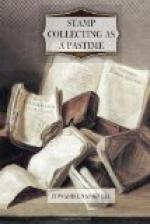Stamps requiring two separate printings—i.e. stamps printed in two colours—have given rise to many curious errors in printing. A sheet passed through the press upside down after one colour has been printed results in one portion of the design being inverted. In the 1869 issue of the stamps of the United States no less than three of the values had the central portions of their designs printed upside down. The 4d., blue, of the first issue of Western Australia is known with the Swan on its head. Even the recently issued Pan-American stamps, printed in the most watchful manner by the United States official Bureau of Engraving and Printing, are known with the central portions of the design inverted, and these errors, despite the most searching examination to which each sheet is several times subjected, escaped detection, and were sold to the public. When, however, it is remembered that stamps are now printed by the million, it will be wondered that so few mistakes escape into the hands of collectors.
As a bit of conceit, the issue of what is known as the Connell stamp is probably unequalled. In loyal Canada, in 1860, Mr. Charles Connell was Postmaster-General of the little colony of New Brunswick, which in those days had its own government and its own separate issue of stamps. A change of currency from “pence” to “cents” necessitated new postage stamps. It was decided to give the new issue as much variety as possible by having a separate design for each stamp. Two of the series presented the crowned portrait of the Queen, and one that of the Prince of Wales as a lad in Scotch dress. Connell, apparently ambitious to figure in the royal gallery, gave instructions to the engravers to place his own portrait upon the 5 cents stamp. His instructions were carried out, and in due time a supply of the 5 cents bearing his portrait was delivered. But before many were issued the news spread like wildfire that Connell had outraged the issue by placing his own portrait upon one of the stamps. Political opponents are said to have taken up the hue and cry. The matter was immediately brought before the higher authorities, and the unfortunate stamp was promptly suppressed. Half a million had been printed off and delivered for sale, but very few seem to have escaped the outcry that was raised against them, and to-day copies are extremely scarce. Poor Connell took the matter very much to heart, threw up his appointment, and forthwith retired into private life. But the portrait of the bluff mechanic type of countenance will be handed down from generation to generation in stamp catalogues and costly stamp collections long after the authorities that suppressed him are forgotten.
Some folks question the appearance of the Baden-Powell portrait upon the Mafeking stamps as a similar bit of conceit; but whatever may be said in criticism of Baden-Powell’s stamp, most people will be inclined to accept it as a pleasant souvenir of an historic siege and a determined and gallant stand against great odds.




